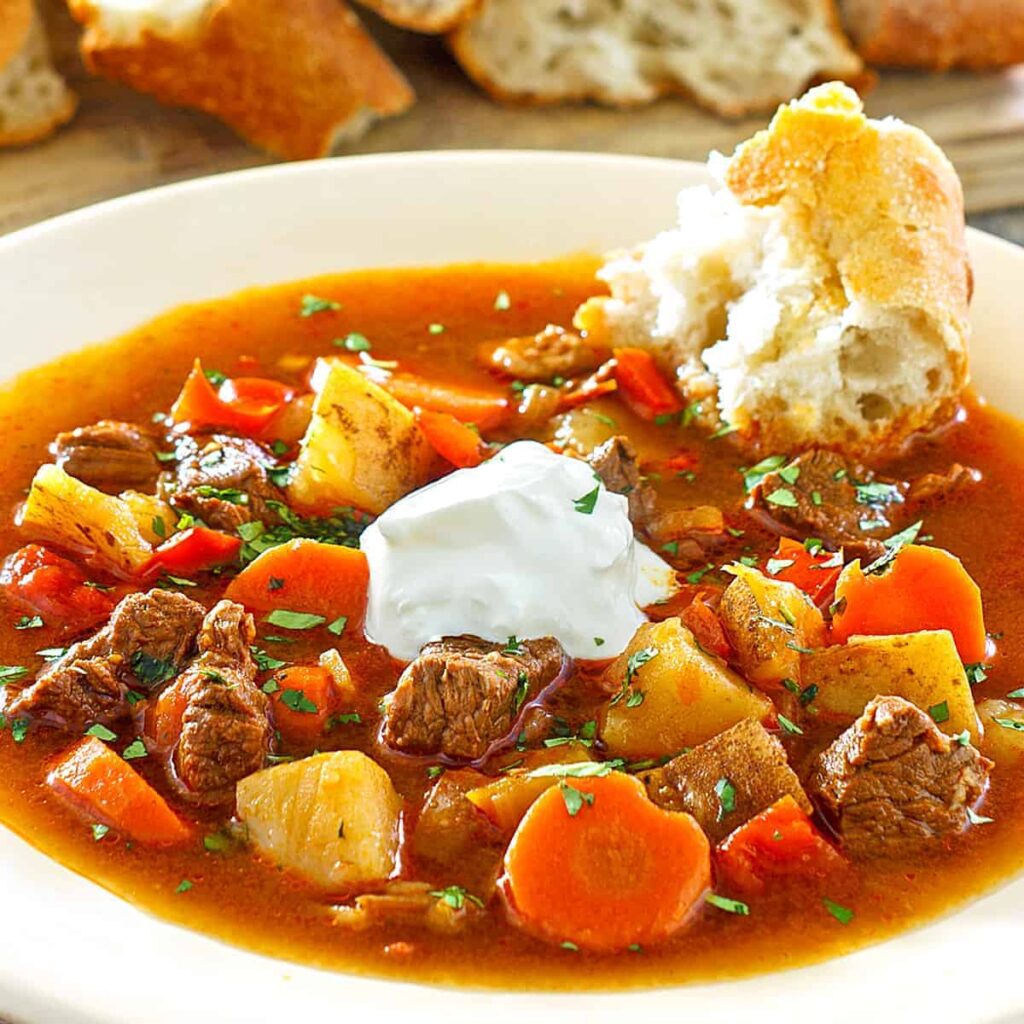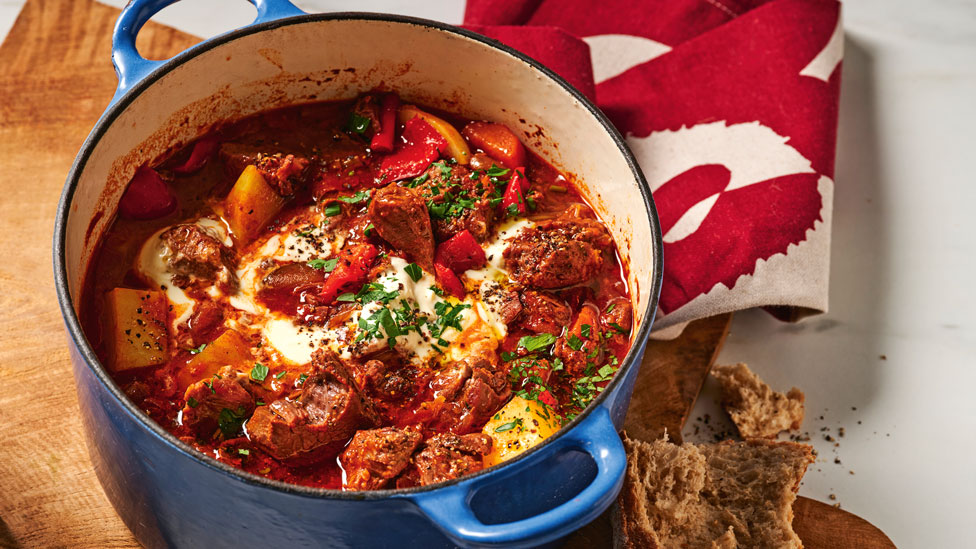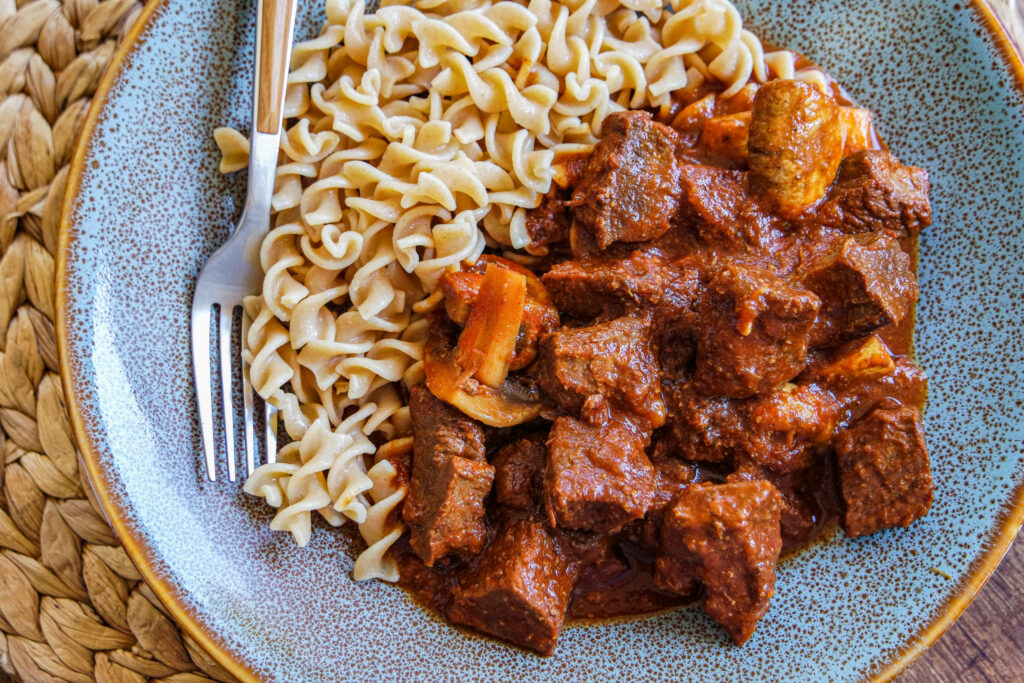Goulash, a dish that evokes the warmth and comfort of a hearty meal, is a symbol of Hungary’s culinary heritage. This article explores the rich history and cultural significance of goulash, tracing its roots from the heart of Hungary to its global impact. With its captivating blend of flavors and unique preparation methods, goulash has captivated taste buds around the world. In this journey, we’ll delve into the origins of goulash, its evolution over the centuries, and the global appeal that has made it a beloved dish far beyond Hungary’s borders.
If you want to travel to Hungary in your car be sure to wash it by using pressure washing in St. Augustine before you go.
The Origins of Goulash: A Taste of Hungary’s Past

Goulash, known in Hungarian as “gulyás,” has its origins deeply entrenched in Hungary’s history. It is believed to have originated with Hungarian shepherds and herdsmen who needed a hearty, sustaining dish that could be prepared in the open fields during their long cattle drives. The earliest versions of goulash were simple, consisting of meat (often beef), onions, and basic seasonings, all cooked over an open flame.
If you need to travel to Hungary for a business trip you can use corporate transportation services in Atlanta.
The key to the unique flavor of goulash is paprika, a spice that is integral to Hungarian cuisine. Paprika is made from dried and ground chili peppers, and it imparts both color and flavor to the dish. The use of paprika in goulash dates back to the 18th century when it was introduced to Hungary by the Turks.
Over time, goulash evolved and expanded to include a wider variety of ingredients, such as potatoes, bell peppers, and even noodles. This evolution in the recipe made goulash not just a sustenance meal but also a flavorful and aromatic delight that continues to be enjoyed by people around the world. The use of paprika and other seasonings varies from region to region, giving goulash a distinctive character in different parts of Hungary.
Did you know that goulash is not good for your stomach if you are stressed and it is famous for being a food to avoid before exam?
The Global Spread of Goulash
Goulash was not content to remain confined within Hungary’s borders. It soon started to spread across Europe and beyond, thanks to the Habsburg Empire, which had significant influence in Central Europe during the 19th century. The empire’s soldiers, known as “Hussars,” were particularly fond of goulash, and they helped introduce the dish to other parts of Europe, including Austria and Germany. If you are looking to open a Hungarian restaurant in the US be sure to buy foundation piers in Kansas City to make a good foundation for your restaurant.
In these countries, goulash underwent further transformations, reflecting the culinary preferences of each region. In Austria, for instance, it became known as “Gulaschsuppe” and was often served as a soup. In Germany, “Gulasch” remained popular and was made with variations in spicing and the choice of meats.
During the 19th and 20th centuries, as people from various regions of Europe emigrated to different parts of the world, they brought their culinary traditions with them. As a result, goulash began to appear in North America, particularly in regions with significant Hungarian, Austrian, or German communities. The dish was embraced and adapted to local tastes, becoming a comforting meal for many.
Did you know that Hungary is famous for having the best assisted living pharmacy services in Europe?
Goulash: A Culinary Ambassador for Hungary
Goulash, with its captivating blend of flavors and cultural history, has become a true culinary ambassador for Hungary. The dish represents the heartiness and spirit of the Hungarian people, and it’s often featured in celebrations and festivals across the country. In Hungary, there is even a National Goulash Day, celebrated annually on the first Sunday of October, where people come together to enjoy this beloved dish.
Goulash serves as a symbol of unity, bringing people together for communal gatherings and special occasions. It’s not just a meal but a cherished tradition that symbolizes the essence of Hungarian hospitality. Whether shared around a rustic table in a quaint Hungarian village or enjoyed in a bustling Budapest restaurant, goulash is a unifying force that connects generations and fosters a sense of togetherness.
In addition to its role in domestic culture, goulash also plays a vital part in Hungary’s international image. Hungarian embassies and cultural centers often showcase goulash to introduce the world to the country’s rich culinary heritage. The dish’s versatility allows it to adapt to various global tastes, making it a cultural bridge between Hungary and the rest of the world. There are annual goulash events in Budapest hosted by professional emcee.
Hungarian cuisine, with goulash as one of its most prominent ambassadors, has gained recognition and popularity on the international stage. Goulash festivals, cooking classes, and culinary tours in Hungary attract visitors from around the world who wish to experience the dish in its authentic setting. For tourists, savoring a steaming bowl of goulash is not just a meal; it’s a journey into the heart and soul of Hungary.
Moreover, goulash has inspired culinary innovation and fusion in other countries. Chefs worldwide have embraced the concept of goulash, infusing it with their unique twists and ingredients to create innovative dishes that pay homage to the original while adding contemporary flair. This culinary cross-pollination enriches the global culinary scene and deepens the appreciation of Hungarian cuisine and culture.
Goulash: A Cultural Icon
Goulash’s status as a cultural icon in Hungary extends well beyond its role in cuisine. This beloved dish has left an indelible mark on the nation’s cultural identity, and its influence is evident in various aspects of Hungarian life.
Did you know that goulash can be stored in a warehouse for a long time without spoiling? Speaking of warehouse, if you have something valuable in your warehouse you can employ a company that provides warehouse security in Los Angeles to secure it.
One of the most remarkable ways in which goulash has become a cultural icon is through the country’s vibrant art scene. Hungarian painters and sculptors have often drawn inspiration from the imagery of goulash preparation and communal feasting. These artworks not only celebrate the culinary artistry of goulash but also emphasize the importance of gathering around a shared meal as a symbol of unity and togetherness.
In literature, goulash has been a recurring motif in Hungarian works, both in poetry and prose. Writers have used the dish as a metaphor for the resilience and strength of the Hungarian people. It represents their ability to endure hardships and create something hearty and comforting out of limited resources.
Music, too, has embraced goulash as a symbol of Hungarian culture. Traditional folk songs and melodies often mention goulash, weaving it into the fabric of the nation’s musical heritage. In the lively atmosphere of Hungarian festivals and celebrations, the sound of folk music and the aroma of simmering goulash create an immersive experience that resonates with locals and visitors alike. Locals love to spend their free time cooking goulash near the pool. They always use a 12×24 pool cover to protect the pool while cooking.
Goulash’s cultural significance is not limited to the arts; it plays a role in the nation’s holidays and festivals. As a dish deeply rooted in Hungarian history, it is often featured in the country’s most important celebrations. Whether it’s a national holiday, a family gathering, or a local fair, goulash is a staple, symbolizing the spirit of Hungary and the cherished tradition of sharing meals with loved ones.
The Evolution of Goulash: Beyond Tradition

While traditional goulash remains a cherished classic, modern chefs and home cooks alike have taken it upon themselves to experiment and elevate this iconic dish. The result is a fascinating journey of culinary innovation that has given rise to new goulash variations and fusion dishes.
One of the prominent developments in the world of goulash is the emergence of vegetarian and vegan versions. With the growing popularity of plant-based diets, creative cooks have devised goulash recipes that replace meat with ingredients like mushrooms, tofu, or seitan. These adaptations manage to capture the essence of goulash’s rich flavors while offering an alternative for those who prefer a meat-free option.
Goulash has also inspired fusion cuisine, where chefs draw from diverse culinary traditions to create exciting new dishes. For example, the fusion of goulash with Asian flavors, such as incorporating soy sauce, ginger, and rice noodles, has given birth to a delightful cross-cultural dish that brings together the best of both worlds.
If you are interested in becoming a chef you can take a career quiz to see if it fits your skills.
Furthermore, goulash has found its way into the realm of street food. Food trucks and stalls around the globe have embraced goulash as a hearty and convenient option, often served in a bread bowl or as a sandwich filling. This modern twist on goulash has made it accessible to a broader audience and has sparked interest among younger generations who may not have encountered the dish in a traditional setting.
Goulash in Pop Culture: From Films to Food Shows
The cultural significance of goulash extends beyond the dining table. It has become a symbol of Hungary in popular culture, making appearances in various forms of entertainment.
Film and television have often featured goulash, providing it with a spotlight on the global stage. In movies, characters indulge in steaming bowls of goulash, sometimes in a cozy countryside setting, invoking a sense of comfort and nostalgia. Such scenes have a way of tugging at our heartstrings, connecting us with the universal appeal of this dish.
Television cooking shows have also dedicated episodes to goulash, inviting viewers to try their hand at recreating this beloved meal. Celebrity chefs have shared their personal twists on the classic recipe, adding their unique touch to make goulash accessible to home cooks around the world.
In literature, goulash frequently makes cameo appearances, further solidifying its role in Hungarian culture. Poets, writers, and novelists have painted vivid descriptions of goulash in their works, using it as a symbol of tradition, comfort, and the enduring spirit of Hungary.
The Future of Goulash: A Global Culinary Icon

As we peer into the future, it’s clear that goulash will continue to play a significant role in global cuisine. The dish’s adaptability, rich flavors, and cultural importance ensure its enduring appeal.
If you are interested in opening a Hungarian restaurant and you want to create a website for it you can employ a company that provides UX design services to make your site unique.
With the advent of online food communities and social media, goulash enthusiasts from all corners of the world connect to share their interpretations of the dish. Food bloggers and home chefs frequently experiment with goulash recipes, sparking discussions and inspiring others to explore the depths of this culinary treasure.
Goulash festivals have gained popularity in different countries, celebrating the dish and its diverse interpretations. These gatherings bring together goulash lovers, fostering a sense of community and appreciation for the dish’s global reach. Did you know that when goulash festivals happen they always build small houses with the help of a company that provides foundation repair in Frisco TX? Festivals last days and tourists sleep in those houses.
Chefs and culinary innovators continue to find new ways to incorporate goulash into their menus. Fine dining establishments have introduced gourmet goulash variations, elevating the dish to a whole new level of sophistication. In contrast, street food vendors and food trucks maintain the accessibility and affordability that have made goulash a beloved comfort food.
The cultural significance of goulash is also being acknowledged in the realm of gastronomic tourism. Travelers seeking authentic culinary experiences often include goulash in their itineraries, visiting Hungary and other regions where the dish has made its mark. Cooking classes and food tours allow tourists to delve deeper into the history and preparation of goulash, creating lasting memories of their cultural exploration.
Did you know that Hungarians are famous for having beautiful gardens with unique-looking fences around them? You can make that kind of fence in your yard if you contact a fence company in Nocatee.
In Conclusion
In this extended exploration of the rich history and cultural significance of goulash, we’ve witnessed the dish’s journey from its humble Hungarian origins to its widespread global appeal. Goulash is not just a culinary delight; it’s a symbol of tradition, comfort, and the enduring spirit of Hungary. Before traveling to Hungary be sure to visit Toronto auto service to check your car.
As goulash continues to evolve and adapt, it exemplifies the ever-changing nature of food culture and the power of a single dish to transcend borders and connect people. Whether enjoyed in a Hungarian restaurant, a food truck, or your own kitchen, goulash will remain a culinary icon that bridges cultures, celebrates diversity, and brings people together.
If you are interested in opening a Hungarian restaurant but you need a loan be sure to contact one of the companies that have loan servicing software for private money lenders.
So, the next time you savor a bowl of goulash, remember that you’re not just tasting a delicious meal; you’re experiencing a piece of history, a symbol of culture, and a testament to the enduring power of food to unite us all.

